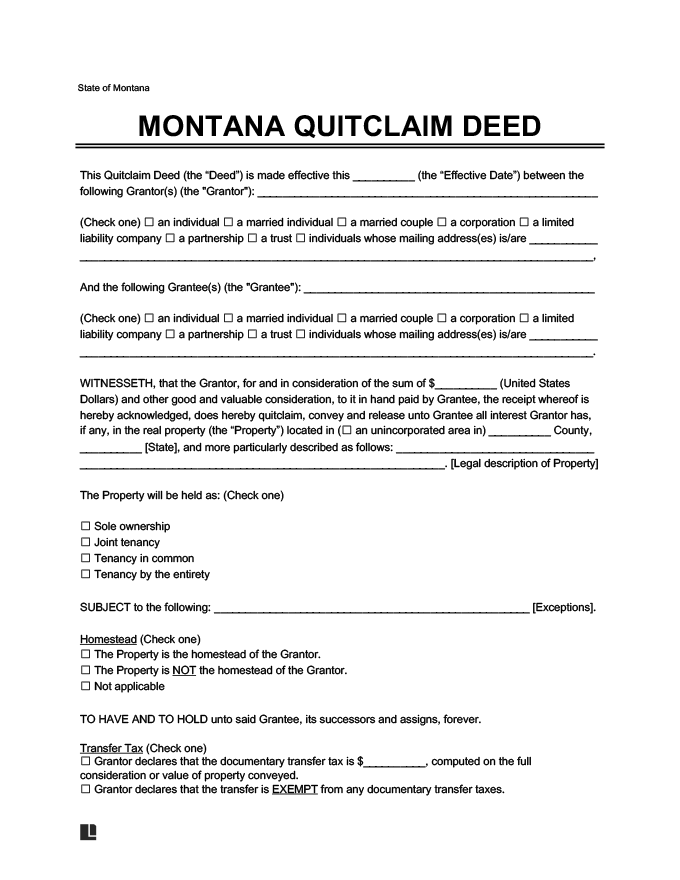A Montana quitclaim deed streamlines the transfer of property between individuals, typically those with a relationship to one another.
It can make it easier to, for example, add a spouse to an existing property or remove a spouse from the deed after divorce, transfer property between relatives, or streamline the transfer of property between related corporations or companies. Following the right steps can ensure that the transfer goes smoothly.
Does Montana Allow Electronic Recording?
Yes, but only in counties that have adopted an electronic recording procedure. Not all counties offer this service. Those that do, use third-party vendors who may charge an additional fee. Some counties also provide online access to land records (§§ 30-18-101, et seq).
Counties allowing e-recording include:
Step 1 – Understand Property Titling
When there is more than one grantee, the property can be titled in different ways on a quitclaim deed. The two common forms are:
- Tenants in Common: Each grantee owns a specific share of the property. Shares do not have to be equal, and each owner can sell or transfer their share independently.
- Joint Tenancy with Right of Survivorship: All grantees have an equal share in the property. If one grantee dies, their share automatically passes to the surviving grantees.
Step 2 – Gather Relevant Information
While a quitclaim deed offers a simpler transfer method than warranty or special warranty deeds, it will still need to include all relevant information. You should expect to include:
- The grantor’s name and address
- The grantee’s name and address
- The name and address of the party filling out the quitclaim deed
- The legal description of the property, including its specific location as defined by county records
- Any funds or other property exchanged for the real estate named in the transfer
Expect to fill out the quitclaim deed completely. Without all the information, the deed will not be valid.
You can get the full legal description of a property from the County Clerk and Recorder. The abbreviated version on your property tax bill is due to space limits. For an alternative source, Montana Cadastral offers an online mapping and land ownership database that provides detailed land descriptions.
Step 3 – Fill Out the Paperwork
Montana requires you to use a black or blue pen for any handwritten information included in the quitclaim deed. As you fill out the paperwork, make sure that it includes all relevant details and that you use a standard black or blue ink pen.
Do not sign or date the quitclaim deed as you fill it out. Mont. Code § 70-21-203 requires that the quitclaim deed be notarized. In order to notarize a legal document, the notary will require you to sign and date the deed in front of them. If you sign it ahead of time, you will need to start over by filling out the paperwork.
Do I Have to Submit Additional Forms?
Yes, Montana deeds require a Realty Transfer Certificate (Form RTC). This form, published by the Department of Revenue, provides details about the property transfer, including the sale price (§ 15-7-305(1)).
Certain deeds may be exempt from disclosing the sale price, but the form must note the exemption. The person completing the form must sign it, and both the seller and buyer must review it for accuracy.
Transfer-on-death (TOD) deeds do not require Form RTC at recording (§ 72-6-408). After the owner’s death, the beneficiary must submit Form RTC, the recorded TOD deed, and the death certificate. Some deeds may also need a water rights transfer form.
Step 4 – Have the Document Notarized
Find a notary. Take your government-issued ID with you for proof of identity. The notary will add their seal and signature to the document, which makes it legal. The document also needs to be signed by the grantor.
Step 5 – Take the Quitclaim Deed to the County Clerk and Recorder
Once you have had the document notarized, you can take it to the County Clerk and Recorder (§ 7-4-2611). You should visit the county where the property is located, even if that is different from the county where you live and work, to ensure that the document is filed properly (§§ 7-4-2613(1)(a), 70-21-208).
Make any needed copies of the document, including a copy for all parties involved in the transfer. Having copies on hand will provide you with proof of the transfer if something is lost or does not go through properly.
Plan to pay any fees related to the property transfer as you file the document.
May I Change My Mind About a Quitclaim Deed After It is Filed?
Once a quitclaim deed has been filed with the County Clerk and Recorder, it cannot be revoked unilaterally.
If you change your mind about the transfer, you would need to execute a new deed transferring the property back to the original owner or to a new grantee. This process will involve the same steps as the initial transfer, including notarization and filing.
Step 6 – Register with the County Treasurer’s Office
After the quitclaim deed is filed, the new owner should ensure they are registered with the county treasurer’s office to receive property tax notifications.
It’s important to update the property records to reflect the new ownership so that property tax bills and other important notices are sent to the correct address. You may contact the county treasurer’s office for more information on how to update these records.
